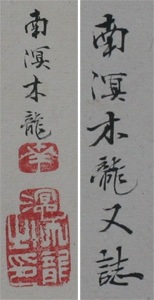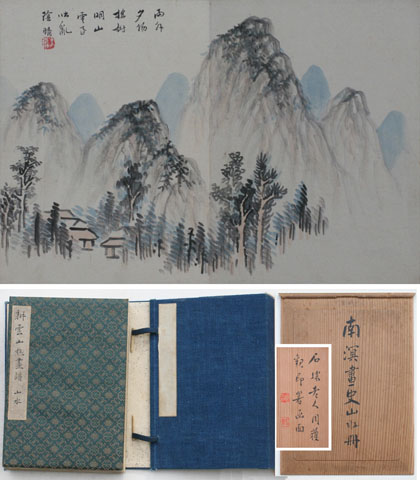Nanga
Kôun Sanshô gafu sansui - Landscapes by Kôun Sanshô (Nammei)Signed: Nammei Kiryû yûshi
Seals: Nammei, Kiryû noin, Kiryû
Technique: colours on paper 17,7 x 12,4
Date: Late Spring of 1864
Box: authorised by Nagasaka Sekitai (1846-1925)
1.Title written by Sekitai, is a Chinese saying: Yuan qi lin li (Living vibrantly). It is dated: Winter 1918.
2. The introduction on Chinese landscape painting is also by Sekitai.
3. Waterfall landscape
4. Houses in a lake
5. Sailing boats and paddy fields
6. House in the mountain
7. Having tea under a pne in the mountains
8. Fishing from a boat in the winter
9. Village with bridge
10. House at a lake with paddy fields
11. Village at a stream
12. Boat in the wind under a cliff
13. Wilow landscape with houses
14. Cabin and mountain tops
15. village at the edge of a cliff
16 House roofs in the mountains
17. Cabin at a lake with a bridge
18. Boat under a tree on a cliff
19. Scholar and pines
20. Hidden village and mountain tops
21-22.The colophon consists of a list of the 24 styles of Chinese painting, two Chinese theoretical texts on Zen painting and Chinese landscape painting, and a text by Dong Qichang (1555-1636) who developed the theory of Southern Painting (nanga).
Haruki Nanmei was the son of Haruki Nanko (1759-1839). He studied with his father as well as with Tani Bunchô (1763-1840).
He was an eclectic painter and in due course became more appreciated in Japan than his assertive father. Quite successful, he managed to find himself a number of patrons in the bakufu. Ultimately his paintings surpassed his father’s both technically and artistically.
Roberts; Berry & Morioka (2008)
Price: ON REQUEST

